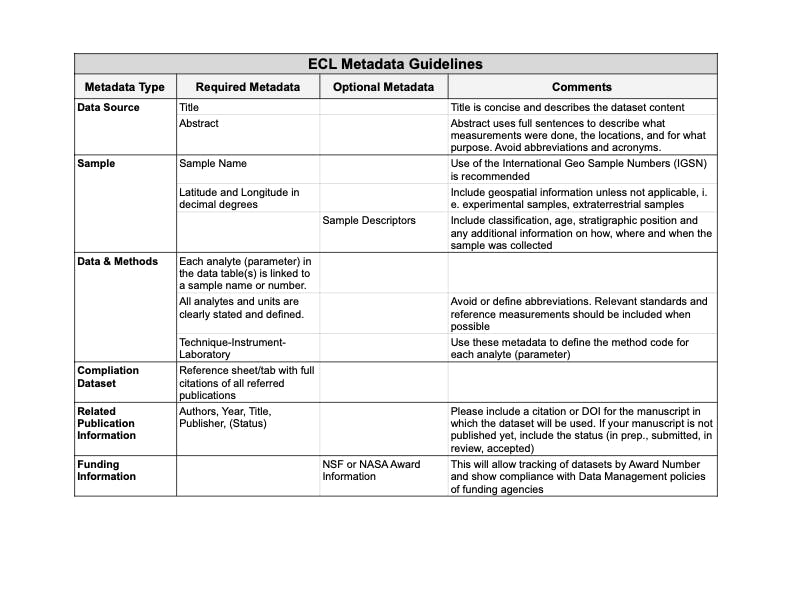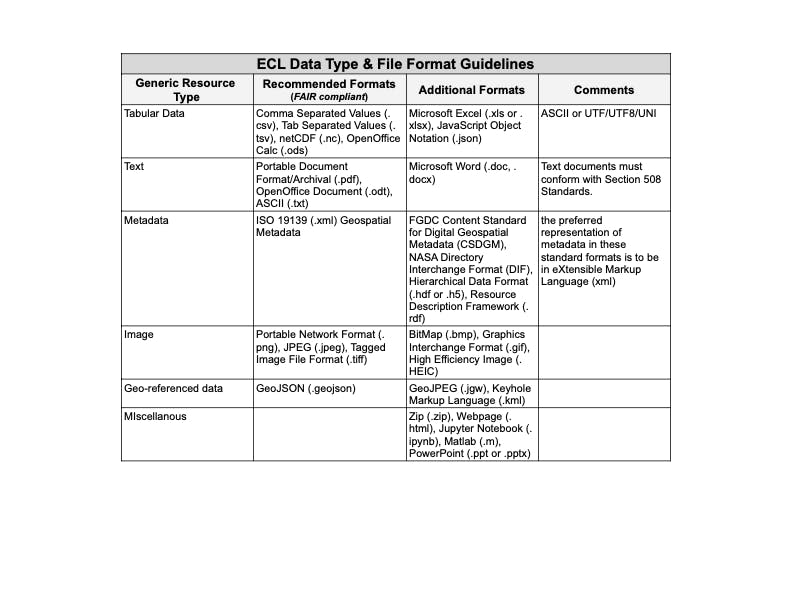Submission Guidelines
The ECL Repository welcomes submissions of geochemical datasets. Please review the following information and guidelines throughout the submission process.
Submission Workflow
Users can initiate data submissions at any time. ECL encourages the use of data submission templates to optimize the submission process. Prior to submission, please review the ECL Submission Guidelines and Policies.
Users must log-in using an ORCiD account to begin the submission process. Don't have an ORCiD yet? Learn more about ORCid and sign up today.
To ensure a submission upholds FAIR (Findable, Accessible, Interoperable, and Reusable) data practices, please accurately and completely document collection method, sample identifiers, data and metadata relevant to the submission.
ECL encourages the use of submission templates throughout the data collection process. Utilizing ECL templates and aligning with our guidelines and policies throughout the data collection process will result in a comprehensive submission for long-term archiving in the ECL.
Once submitted, the curation process will begin. The curation process can take up to two weeks to complete.
Need additional guidance in preparing a submission?
We're here to help! Email us at info@earthchem.org and a member of our Curation Team will respond quickly.

Curation Workflow
Once submitted, each dataset undergoes a curatorial review for relevance, completeness, and other key considerations.
The ECL Curation Team conducts a review for quality of sample and analytical metadata, not a review of the submitted data itself. The contributor of the dataset is responsible for ensuring quality of the submission.
To ensure the fastest turn-around time for curation services, please ensure compliance to ECL submission guidelines and policies.
Submission Templates
- We strongly recommend the use of data submission templates, tailored for specific data types, to ensure reproducibility of the data and easy conversion to machine-readable formats.
- Templates are available for various data types such as bulk analysis (majors, traces, isotopes), mineral analysis (in-situ analysis), and melt inclusion analysis.
- Review the Submission Templates page for guidance on using and accessing the appropriate template for your data type.
- If a template does not yet exist for your data type, you may contact us about creating one at info@earthchem.org.
Metadata Requirements & Best Practices
Required Data & Metadata
- All analytes, units, technique, instrument, and laboratory must be clearly stated and defined. Relevant standards, reference measurements, and additional information about instrument calibration should also be included when possible.
- Every analyte must be linked to a sample with a sample name and geospatial information (unless not applicable, i.e. experimental samples).
- We strongly recommend the use of IGSNs (International Generic Sample Number) as persistent identifiers to identify samples. Obtain IGSNs by registering samples in the System for Earth Sample Registration (SESAR).

Metadata Best Practices
- Your dataset title must contain concise and descriptive information about the content of the dataset (the “what” and “where”, for example “Gakkel Ridge basalt melt inclusion and mineral chemistry”). If submitting data from a publication, the dataset title may be the same as your publication title, but can be different since your ECL dataset will paint a different story than your full publication.
- Your abstract must describe in full sentences the measurements, location, and purpose of the dataset. The abstract should be <250 words and different from your related publication abstract. Avoid abbreviations and acronyms. Include relevant keywords, such as the geographic area or cruise or field program name, for example “This dataset presents analyses of volatile, major, and trace elements for a suite of glasses and melt inclusions from the 85 degrees E segment of the ultra-slow spreading Gakkel Ridge”.
- In general, strive to ensure that your metadata is correct, complete, concise, and descriptive
- Include as much documentation as possible, taking particular care to include unique identifiers such as IGSNs, related publication DOIs, volcano numbers, cruise DOIs, etc.
- We strongly encourage US-based researchers to link their NSF award numbers with their ECL datasets. This will allow tracking of datasets by award number and demonstrate compliance with Data Management policies of funding agencies.
- Ensure your uploaded file is in its final form – the EarthChem Library is a long-term repository, treat the dataset submission like a journal article submission. Once a file has been released for public access, it cannot be changed, instead you would have to publish a new version with a new DOI
Compilation References
- If submitting a compilation dataset, the ECL requires the submission of references with full citations of all referred publications.
Data Types & File Formats
- ECL accepts submissions aligned with the data types outlined below. If the data type of your submission does not align with a pre-existing submission template, the data submission must be supplied in one of the accepted file formats.
- If you have questions on accepted file formats or submission templates, please contact the ECL Curation Team at info@earthchem.org

File Name & Extension Criteria
File names can only contain upper or lowercase letters, numbers, spaces, _(underscores), -(dashes), and parenthesis().
Data file extensions must comply with accepted file extensions; see the complete list of allowed file extensions.
File Size Upload Limit
The largest permitted file size is 50 MB. Per submission, the largest permitted total upload size is either 20 files total or 400 MB total, whichever criteria is met first.
Selecting a Release Date
By default, the release date of your dataset is set to the date of submission. However, the data contributor may select to embargo the submitted data files for up to two years from the date of submission. Datasets with a delayed release date have landing pages and are searchable in the ECL even though the associated data files are not available for download. This is to ensure compliance with data management policies of funding agencies without releasing the data files upon registration of the DOI.
Selecting a Data Licensing Option
Data contributors have 4 data file license options to choose from for preserving and enabling continuing access and use of data and related information. Selecting an open access license (marked with an asterisk, below) is strongly encouraged. The license selection is displayed on the landing page of a given dataset.
Incorporating Datasets in PetDB/EarthChem Synthesis
PetDB is a searchable database of published geochemical data for igneous and metamorphic rocks. If you are submitting a geochemical dataset to EarthChem Library derived from igneous and metamorphic rocks you may also suggest your dataset for inclusion in PetDB. PetDB only includes geochemical data that has been published. This includes data from peer-reviewed publications and data that has been published online through the minting of a dataset DOI (such as the ones provided by the EarthChem Library).
If an EarthChem Library dataset is suggested for PetDB by the contributor and has a related manuscript that is in preparation or under review, the dataset will be reviewed for inclusion in PetDB upon publication of the related manuscript. A dataset submitted to the EarthChem Library without a related publication is immediately available for consideration.
Not all datasets submitted to the ECL qualify for inclusion into the PetDB Synthesis, even if the inclusion was requested by the data contributor. If you have questions as to why your dataset was or was not synthesized into PetDB, please reach out to the ECL Curation Team at info@earthchem.org.


